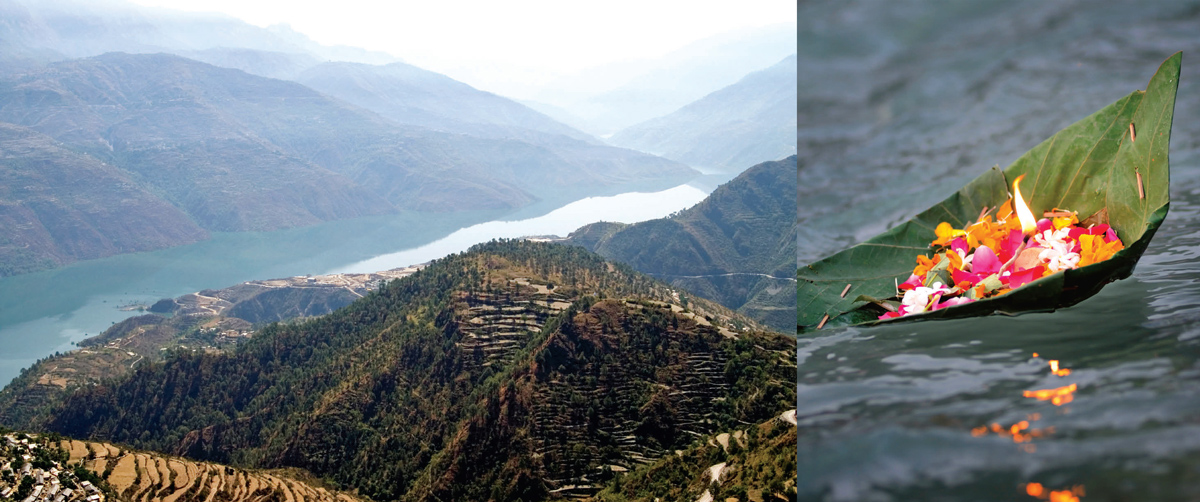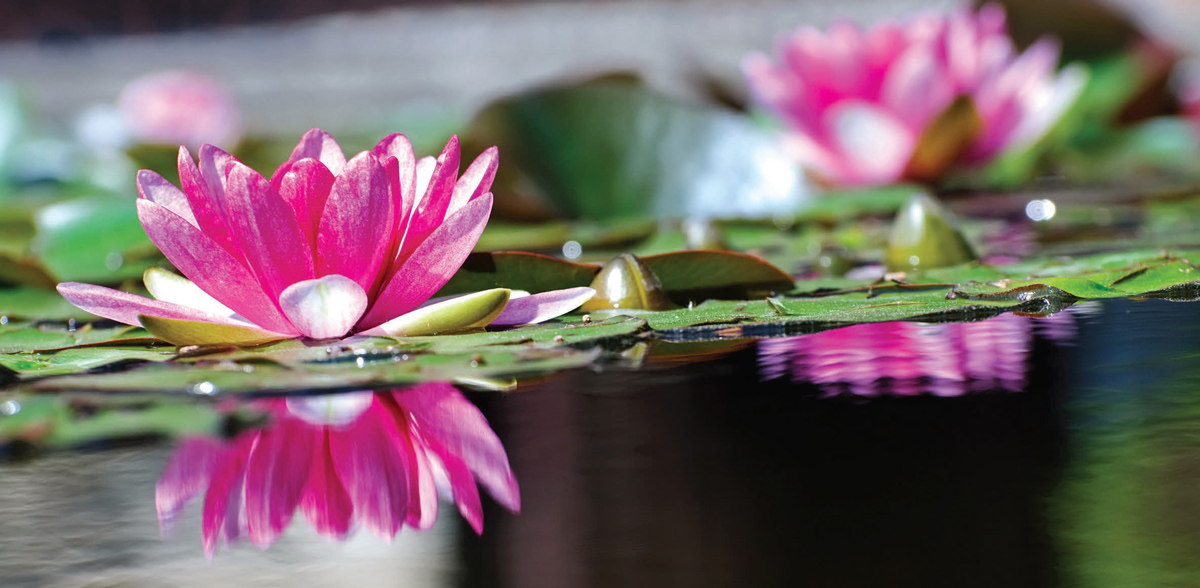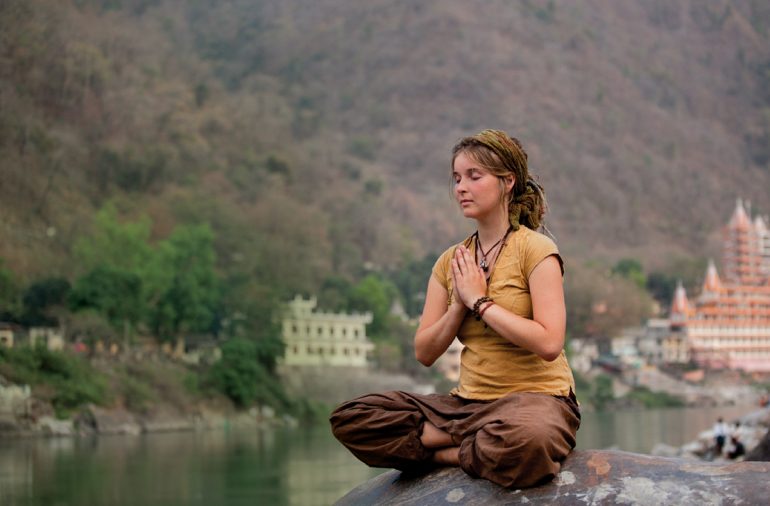Shraddha! Shraddha! And only shraddha (faith) can describe the flow of divine grace at the Mahakumbh Mela, spanning the auspicious time of January to March 2013. The Mahakumbh unfolded the experience of the Divine Feminine lila (play) amidst thirty millions souls that traversed her river ghats (steps) on the auspicious snana (bathing day) of February 10. A special juxtaposition of heavenly stars brings to earth the power and grace of the cosmic universe in the embrace of the Devatas, or divine beings, and their celestial dance at the most powerful and auspicious confluence of Ganga, Yamuna and the mythological Saraswati Rivers at Prayag (Triveni Sangam). According to ancient traditions these holy rivers offer purity, wealth, fertility and divine grace, washing away the misfortune of our samskaras and karmas from many lifetimes.
Triveni where the three rivers meet is a place of pure soma (elixir), where the eclectic powers of the sacred waters cleanse and empower the soul in its humble journey to cosmic consciousness. The sacred waters embrace humanity as one, making no distinction of rank, color, caste or creed. Everyone is drawn to step down from the pedestal of Maya (illusion) and bow at the lotus feet of Ma Ganga.
Ardhakumbh and Mahakumbh, the lesser and greater Kumbh festivals, are occasions when millions of people gather together to take a holy dip in the sacred waters of Ma Ganga. it is believed that bathing in the sacred rivers during Mahakumbh or Ardhakumbh draws one out of our karma or the cycle of life and death and grants one moksha. Devotees, sants (holy persons) and sadhus (renunciates) arrive in great numbers from all over the world to bathe in the holy waters of these sacred rivers.
Faith where knowledge meets devotion
Shraddha where jnana meets with bhakti. The surge of bhakti and shraddha (devotion and faith) amidst the millions of beautiful souls i rubbed shoulders with on this auspicious day melted my body, mind and heart into sheer humility. Shraddha is deep faith in the ancient wisdom of india’s sacred traditions, where jnana (knowledge) meets with bhakti (devotion) in the heart of every spiritual seeker. Such faith is the trust born of intense devotion and conviction woven through the principles of Sanatan Dharma.
Shraddha, or deep faith and belief, is the feeling of sensitivity, discernment, and understanding with conviction and trust in the cosmic powers of the universe. Shraddha without insight and perception lures us into the dragnets of illusion and personality cults. Shraddha must be born out of awareness, clarity, discrimination, maturity and responsibility. Shraddha is the mark of bhakti that unfolds love and compassion as an expression of gratitude, nurturing and inspiration. Divinity must guide us into conscious relationships, allowing all beings to experience healing and harmony at the deepest core on a universal level.
Adhvara – a sacred journey
This Mahakumbh unfolded a sacred journey or Adhvara towards a deep inner light. Adhva means path and ra means movement. it is the soul of a sadhak’s pranic Shakti that soars like the Shyena or hawk. The Shyena masters its flight into the cosmic heavens, perfecting all its energies while balancing its physical body speeding through the air.
Allying its wingspan with the cosmic prana, the Shyena returns to Mother Earth in a divinized form. The aim of vedic Yoga is to establish harmony and perfection, developing the inner potential and prana energy to draw in and hold the inherent Soma, the delight of existence.
The Mahakumbh Mela is an expansion and experience of collective consciousness, where millions of souls gather in harmony on one auspicious day. The calm and peace one experiences is of a deep awareness and understanding of one’s relationship with the mystic surroundings. Sanatan Dharma is a way of life for everyone in india. There are deep levels of love, compassion and tolerance to be learnt at the core level of being with the general janata (people) of India. There is a flow of divine grace, which gets lost in the drama, fanfare and public histrionics of spirituality today.
One decided to be with the crowds to experience the heartbeat of Ganga in every bhakta or seeker, a very deepening lesson in self-effacement and compassion for me. At the Kumbh one watched an entire deeper dimension of humanity walk by as sun rays filtered through hues of saffron robes and alta (red) colored feet sounding the jingle of their payals (anklets) through strains of silent prayers and invocations to the Divine. Such devotion can only be envisaged in the bhumi, or land of Shakti, the Mother Goddess in India.
From dawn to dusk there was a bustle of human connectivity, woven together with the divinity of the rivers through prayers, propitiations, meditations, chanting and bathing in the holy waters. Ma Ganga took care of each gentle soul walking by her space at Triveni with shelter, food and divine grace. by the setting Sun, groups huddled together around a central fire sharing their experiences over glasses of hot chai (tea). Fires were kindled for food and warmth.

People rested in the embrace of the good earth under the warmth of a blanket by the sides of the dirt roads. in their deep sleep were the whispers of eternity awaiting the dawn of another auspicious day.
Mauna – the inner silence

Walking with the multitude of people, crossing newly set up manmade bridges, everyone’s prayer guided them to the waters for the auspicious dip, the Mauni Amavasya (new Moon). The Mauni Amavasya is the new moon during the hindu month of Magha when both the Sun and Moon are located in the constellation of Capricorn. Mauni refers to an ascetic who practices mauna (silence). Silence is not the mere control of speech with lips sealed tight. Mauna means analyzing, synthesizing, and internalizing with the Divine within, hearing the inner voice above all outer sounds. Mauna is a beautiful and important aspect of tapas or spiritual discipline. it symbolizes a state of oneness with the self, initiating an inner dialogue with divinity. it allows us to control the mind and all of our sensory organs to experience the eternal flow of soma.
Revering our own inner sacredness deepens one’s awareness of the Self, tapping the aura of divinity through observing, healing, rejuvenating, restoring and celebrating our core existence. Desires, wishes and expectations abound in our everyday life enhancing our worldly attributes and increasing our demands and expectations. The key to physical, psychological and spiritual wellbeing rests in modulating our outer needs to harmonize our inner needs, and in the process harnessing the powers of the mind and heart.
The rush of heartbeats and pounding feet of the procession of Naga Babas rendered the mauna or silence of the Amavasya void, as a surge of prana moved through their bodies towards the sacred waters. There was a paradigm shift in the cosmic energies as brightly decorated chariots passed by with spiritual leaders and heads of great monastic lineages (Mahamandaleshwaras) sweeping up a palpable euphoria among their devotees strewn along the path. Flashing at times bloodshot eyes conveyed heightened levels of energy. Yet eyes are powerful and convey the expression of the soul stirrings, if the body, mind and soul are calm. As i gently inquired about the purpose of the pilgrimage for everyone at the Mahakumbh, unanimously the answer was “Ganga Mayee” or Mother Ganga.
The river is a metaphor for life
Through my many years of sadhana along the banks of Ma Ganga, the river became a metaphor for life. A metaphor is no mere word play but reflects a deeper inner reality, symbol or allegory that is more significant than anything we may perceive outwardly. When we relate to the element of water, we are expressing a flow of inner truth that is accessible for everyone. our core feeling nature, our soul, our inner and outer lives manifest as a flow of waters or currents of various streams.
The Ganga River holds the intrinsic Shakti of the cosmos in its powerful and at times gentle flow. Ganga carries with it the healing grace of the himalayan sanjeevani plants or healing herbs. She bears the clumps of Mother Earth as she takes in the soft embankments in her journey through the mountains and into the plains. The river filters through thedebris of many centuries as she purifies the souls of millions of devotees who seek the blessings in her celestial waters.
The river’s course is a meditative study of life rushing forth from the melting waters of Mother Earth’s womb, cascading the heights of waterfalls in childhood mirth, meandering through youthful springs and autumnal changes into its eventual resting place in the deep recesses of the great ocean. The river’s course weathers the peace and fury of nature’s moods, muddying its pristine waters from rainy storms, collecting the debris of its embankments. Yet in its eventuality the river mirrors the clarity and beatitude of the ocean’s vastness in its sedate finality beneath the vast sky.

Meditating on the river’s flow is a natural form of sadhana that draws one into whirlpools of heavenly waters, maneuvering past the surface waves of life’s illusory movements into the invisible secret currents behind them. The hypnotic effect of Ganga’s mystic vapors secedes all worldly sensory expressions luring one into a stupor of natural serenity and stillness. its meditative silence lures the purity of Mother nature’s nurturing calm, churning the mind’s chaos into realms of contemplative bliss.
Ma Ganga holds the Vajra Shakti or lightning blaze in her cosmic waters of eternal time and infinite space, as her rapid effulgence captures the sparkle of the diamond that reflects the momentum of our earthly lila scripting the wheel of samsara (journey). Worshipping Shakti through surrendering to its transformational nature, we align ourselves with the universal power of divine grace, with blessings for all.
Sacred dharma relates to all aspects of our life through the lila or divine play of the Goddess’s energy in Maha Prakriti (Great nature), the five great elements of earth, fire, water, air and ether, and the overflowing abundance of nature. We must rediscover the universal love dwelling within our own hearts for the whole of life. in the union of our deepest self with the Mother Goddess, there is a divine beauty and purity that reinforces our innate sacredness and the wonder of all existence. May we flow as the grace and sweetness of the river’s all-embracing Divinity.
 Shambhavi Chopra is a mystic, yogini and spiritual guide. She is a dynamic teacher of Shakta or Goddess traditions of India. She draws the seeker through Shakti Sadhana and Tantra, emphasizing the role of the “Divine Feminine Power,” creating an inner and outer transformation through meditation, sacred rituals, mantra japa, healing and Pratyahara. Shambhavi has written bestselling books. vedanet.com
Shambhavi Chopra is a mystic, yogini and spiritual guide. She is a dynamic teacher of Shakta or Goddess traditions of India. She draws the seeker through Shakti Sadhana and Tantra, emphasizing the role of the “Divine Feminine Power,” creating an inner and outer transformation through meditation, sacred rituals, mantra japa, healing and Pratyahara. Shambhavi has written bestselling books. vedanet.com







